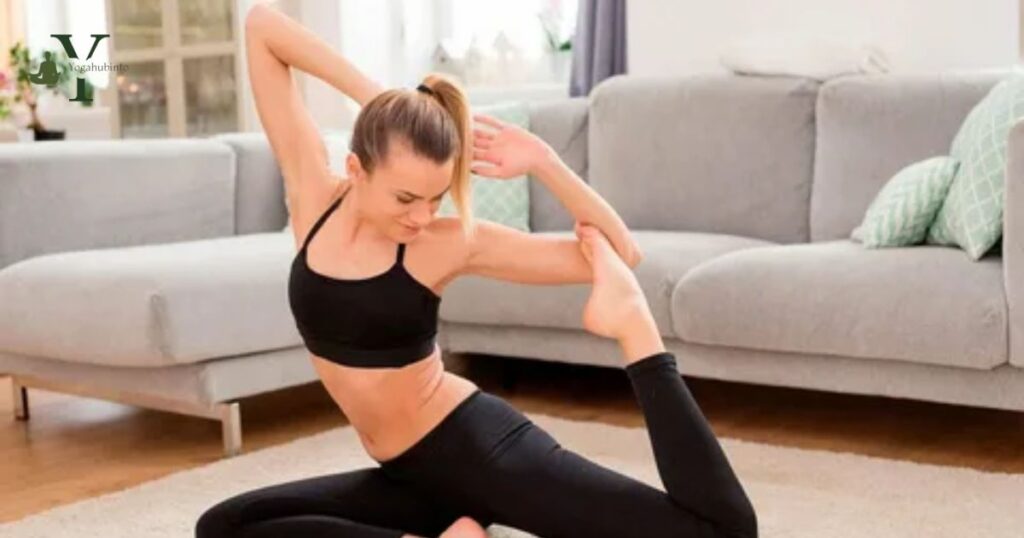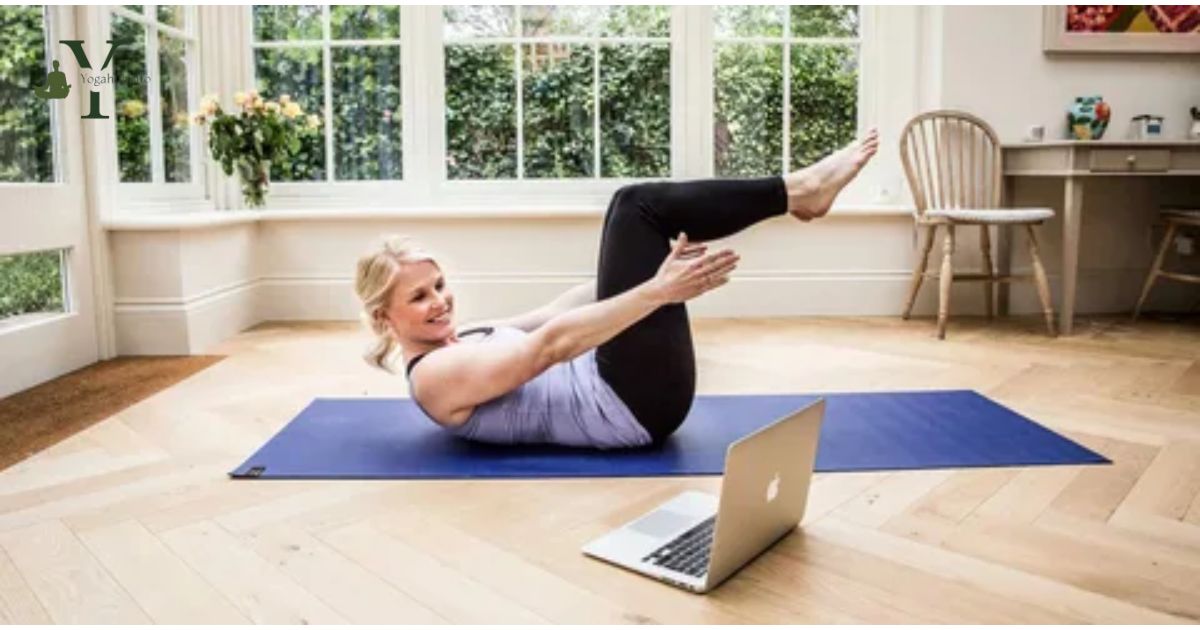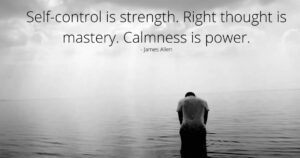Answer: Aim for 3-5 sessions per week for consistent progress, but listen to your body and enjoy the journey.
Unfolding your yoga mat for a few sessions each week is the sweet spot for progress. Start with 2-3 times and gradually build to 3-5 as you feel stronger. Rest, listen to your body, and even short daily bursts count. Remember, consistency is key, not contortions. Above all, relish the journey, because yoga is about feeling connected and grounded, not just perfecting the perfect pose.
Unlock the secrets to yoga success by determining your ideal practice frequency. Wondering how often to roll your mat? Discover the sweet spot for visible results. Explore the world of fitness and create the perfect routine. Transform your life and experience lasting benefits through consistent yoga practice.
Yoga gains take time, not rush. Start with 2-3 chill sessions weekly, like mini massages for your soul. Feeling bendy? Go for 3-5 as you groove. But rest rocks! Listen to your body, even quick daily stretches work wonders. Remember, it’s about feeling good, not looking like a pretzel. Enjoy the flow, your yoga glow awaits.
How do you know what’s right for you?

Finding your perfect yoga rhythm
Listen to your body: It’s the best yoga teacher you’ll ever have. Notice how you feel after different practice lengths. Does a daily flow leave you energized, or do you need rest days? Tune in to your body’s whispers.
Start small, grow steady: Begin with 2-3 sessions a week, focusing on consistency over intensity. As you ease into the practice, gradually add sessions if your body craves more. Remember, slow and steady wins the yoga race!
Celebrate every bend: Don’t get caught up in comparing your practice to others. Every pose held, every breath taken, is a victory! Focus on your own journey, and enjoy the feeling of progress, however small.
Remember, the right yoga practice is the one that feels good for you. Listen to your body, start slow, and celebrate every step on your personal yoga journey!
Create a routine and get results with your personalized Skill Yoga plan
| Time | Activity |
| 5 minutes | Warm-up: Gentle stretching |
| 10 minutes | Sun Salutations: Flowing sequence of poses to warm up the entire body |
| 15 minutes | Standing Poses: Warrior poses, tree pose, etc. for strength and balance |
| 10 minutes | Seated Poses: Forward bends, twists for flexibility |
| 10 minutes | Core Exercises: Planks, boat pose, etc. for core strength |
| 10 minutes | Backbends: Cobra, bridge pose, etc. for spine flexibility |
| 5 minutes | Cool Down: Gentle stretches and relaxation poses |
| 5 minutes | Meditation: Focus on breathing and mindfulness |
| Total Time | 60 minutes |
In today’s fast-paced world, finding balance and maintaining a healthy lifestyle can be a challenge. Amidst the hustle and bustle, incorporating a routine that focuses on your overall well-being is crucial. One such powerful routine that combines physical, mental, and spiritual wellness is Skill Yoga – a personalized approach to yoga that tailors the practice to your unique abilities and goals.
Embrace Personalization for Optimal Results
Unlike generic fitness routines, a personalized Skill Yoga plan takes into account your individual strengths, weaknesses, and aspirations. This customized approach ensures that every pose and sequence aligns with your body’s capabilities, making the practice more effective and sustainable. This personalization not only enhances your physical strength and flexibility but also nurtures your mental and emotional well-being.
Building a Routine that Works for You
Creating a routine around your personalized Skill Yoga plan is the key to unlocking its full potential. Here’s a step-by-step guide to help you get started:
Assessment and Goal Setting
- Begin by assessing your current fitness level, flexibility, and overall health. Set realistic and specific goals, whether they involve improving flexibility, building strength, reducing stress, or enhancing mindfulness.
Consultation with a Skill Yoga Expert
- Seek guidance from a Skill Yoga expert who can analyze your needs and create a personalized plan tailored to your body and objectives. They will help you understand which poses and sequences will work best for you.
Establish a Consistent Practice Time
- Consistency is key in any fitness routine. Choose a time of day that suits your schedule and commit to practicing Skill Yoga regularly. This could be in the morning to energize your day or in the evening to unwind and relax.
Create a Dedicated Space
- Designate a quiet and clutter-free space for your Skill Yoga practice. Having a dedicated area enhances focus and ensures that you have everything you need for a successful session.
Mindful Warm Up
- Before diving into your Skill Yoga routine, engage in a mindful warm-up to prepare your body and mind. Gentle stretches and controlled breathing will help you ease into the practice and prevent injuries.
Follow Your Personalized Plan
- Stick to the personalized Skill Yoga plan crafted for you by your expert. Focus on mastering each pose and sequence, gradually progressing as you build strength and flexibility.
Reflect and Adjust
- Regularly reflect on your progress and adjust your routine as needed. Your Skill Yoga expert can provide feedback and modify your plan based on your evolving goals and capabilities.
The Results Speak for Themselves
By integrating a personalized Skill Yoga plan into your routine, you embark on a transformative journey that goes beyond the physical. Experience increased energy, improved mental clarity, reduced stress, and a heightened sense of well-being. As you witness positive changes in your body and mind, you’ll find the motivation to stay committed to your routine, ensuring long-term success on your wellness journey.
In conclusion, creating a routine around your personalized Skill Yoga plan empowers you to take charge of your well-being. Embrace the journey, savor the progress, and let the results inspire you to achieve new heights in your physical and mental fitness.
How long or short should your yoga practice be?

Determining the Ideal Duration for Your Skill Yoga Practice.
Tailoring Your Practice Duration
Short Sessions (15-30 minutes):
Ideal for busy schedules, the yoga practice in these short sessions focuses on key poses, breathwork, and meditation. This approach is well-suited for daily consistency, offering a convenient option for individuals with hectic routines.
Focus on the yoga practice remains key during these sessions, allowing practitioners to efficiently incorporate essential elements into their daily lives. The short duration caters to the needs of those with time constraints, promoting regular engagement.
Moderate Sessions (30-60 minutes):
Within the moderate sessions lasting 30-60 minutes, the yoga practice becomes more comprehensive. This duration permits a well-rounded approach that includes warm-up, a variety of poses, and relaxation techniques.
The moderate yoga practice strikes a balance between physical and mental benefits, acknowledging the importance of both aspects in fostering overall well-being. This session duration is ideal for those seeking a more extensive and nuanced yoga experience.
Extended Sessions (60+ minutes):
Extended sessions, lasting 60 minutes or more, cater to individuals with the luxury of time and experience in their yoga practice. This extended duration provides opportunities for advanced poses and prolonged meditation, enhancing both physical and mental endurance.
The yoga practice in these longer sessions is designed to delve deeper into the intricacies of the discipline, allowing practitioners to explore advanced techniques and challenges. This extended format contributes to a more profound and enriching yoga experience.
Experiment and Listen to Your Body
Determining the ideal duration for your Skill Yoga practice is a personal journey. Experiment with different lengths to discover what works best for you. Pay attention to how your body responds and adapts over time, as this self-awareness is integral to the yoga practice.
Consistency is key in your yoga journey, and finding a duration that suits your lifestyle without feeling overwhelmed is crucial. The yoga practice should be a mindful exploration of your body and mind, fostering a sense of balance and well-being in your daily life, whether in short, moderate, or extended sessions.
Remember, the essence of Skill Yoga lies in the journey, not just the destination. Each session, whether short or long, contributes to the ongoing exploration of your body and mind, promoting a holistic sense of balance and well-being.
Is it possible to do yoga and work out at the same time?

Yes, it is absolutely possible to do yoga and work out at the same time! In fact, combining the two can bring a whole new dimension to your fitness routine. Here’s how:
1. Synergistic Benefits
Yoga and traditional workouts target different aspects of fitness. Yoga focuses on flexibility, balance, and mindfulness, while traditional workouts like weightlifting or cardio build strength and endurance. Combining them creates a well-rounded workout that benefits both your body and mind.
2. Sequencing Matters
The order you do things matters. Ideally, do yoga after your traditional workout. This is because yoga’s static stretches can decrease muscle power if done beforehand, impacting your workout performance. Yoga’s cool-down and mindfulness aspects are perfect for post-workout recovery and stress reduction.
3. Choose Your Yoga Wisely
Not all yoga styles are created equal. If you’re looking for a high-intensity workout, Vinyasa or Ashtanga yoga can be great options. For something gentler and more focused on recovery, Yin yoga or restorative yoga are perfect choices. Listen to your body and choose a style that complements your workout goals.
4. Hybrid Workouts
Want to get really creative? Try some hybrid workouts that combine yoga poses with bodyweight exercises or light weights. For example, you can do lunges in Warrior III pose or squats in Chair pose. These can be a fun and challenging way to break up your routine and work multiple muscle groups at once.
The key is to listen to your body and find what works best for you. Start slow, experiment with different combinations, and enjoy the journey of blending yoga and traditional workouts into a powerful fitness routine.
Can I do yoga 3 times a day?
Whether you can do yoga 3 times a day depends on a few factors:
1. Your Experience
- Newbies: Start slow. 1-2 short sessions daily might be ideal. Build up gradually to avoid injury.
- Seasoned Yogis: 3 daily sessions could be doable, but mix them up for variety. Go gentle some days, intense others. Listen to your body.
2. Session Length
- Short & Sweet: 15-20 minute sessions can be great for stress relief and daily movement, even 3 times per day.
- Full Flow: Longer sessions (60+ minutes) might be best done 1-2 times daily, with additional shorter practices if desired.
3. Your Goals
- Flexibility & Relaxation: Multiple gentle sessions can work wonders.
- Strength & Fitness: Combine yoga with other workouts, but give your body rest between sessions.
Remember
- Listen to your body! Stop if you feel pain or discomfort.
- Prioritize quality over quantity. Focus on mindful practice.
- Rest and recovery are crucial. Don’t overtrain.
Frequently Asked Questions
How soon will I see results?
It depends! Consistency is key, but results like increased flexibility and stress reduction can show within weeks, while significant strength gains might take months.
Is daily practice ideal?
Not necessarily! 3-5 times a week is great for most, with one rest day. Newbies can start with 1-2 sessions, and advanced yogis may benefit from daily practice with gentle variations.
Can I overdo it?
Absolutely. Listen to your body! Overtraining can lead to injury. Rest when needed, and prioritize quality over quantity in your practice. ♀️
What if I miss a session?
Don’t sweat it! Pick up where you left off. Consistency is important, but occasional breaks won’t derail your progress.
Should I do short or long sessions?
Both have benefits! Short bursts (15-20 mins) are great for stress relief and daily movement. Longer sessions (60+ mins) offer deeper stretches and strength gains. Mix it up based on your goals and energy levels.
Final Thoughts
Consistency is key when it comes to seeing results from your yoga practice. While individual preferences and schedules may vary, a general recommendation is to practice yoga at least three to four times a week. This frequency allows for the body to adapt, improve flexibility, and build strength over time. However, quality should always take precedence over quantity, ensuring each session is focused and mindful.
The benefits of a regular yoga practice extend beyond the physical realm, impacting mental and emotional well-being. Yoga serves as a powerful stress reliever, promoting relaxation and mindfulness. To experience these mental health benefits, integrating yoga into your routine on a regular basis is essential. Even shorter, more frequent sessions can contribute to a sense of balance and tranquility in your daily life.
It’s important to acknowledge that individual results may vary based on factors such as dedication, intensity, and the specific goals of your yoga practice. Some practitioners may notice improvements in flexibility and strength within a few weeks, while others may take longer. Regardless of the timeline, the key is to remain patient, stay committed to your practice, and celebrate the holistic well-being that yoga brings into your life over time.
Unfurl your yoga mat and blossom into your best self! Discover the ideal practice frequency to cultivate flexibility, strength, and inner peace.

Marcus Evergreen, with 8 years of yoga expertise, is the author behind yogahubinfo.com, sharing insights and wisdom in holistic well-being.











